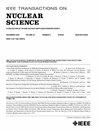3D-Printed Plastic Scintillator: A Potential Avenue for Hetero-Structured Radiation Detectors
IF 1.9
3区 工程技术
Q3 ENGINEERING, ELECTRICAL & ELECTRONIC
引用次数: 0
Abstract
The concept of a heterostructure-based scintillation detector has been proposed as a potential alternative to current time-of-flight positron emission tomography (TOF-PET) detectors. In a heterostructure design, a dense scintillator (matrix) works in synergy with a fast-timing light scintillator (filler). The design often includes complex geometries, necessitating precise machining. The application of 3D printing technology can facilitate the fabrication of such complex geometries. This study presents the formulation and fabrication of a 3D-printed plastic scintillator, which has been identified as a potential filler material. The developed scintillator shows better rise and decay times compared to commercial plastic scintillators such as EJ-200. We have measured a coincidence time resolution (CTR) of 225 ps using3d打印塑料闪烁体:异质结构辐射探测器的潜在途径
基于异质结构的闪烁探测器的概念已经被提出,作为当前飞行时间正电子发射断层扫描(TOF-PET)探测器的潜在替代品。在异质结构设计中,密集闪烁体(基质)与快速定时光闪烁体(填料)协同工作。设计通常包括复杂的几何形状,需要精确的加工。3D打印技术的应用可以促进这种复杂几何形状的制造。本研究提出了一种3d打印塑料闪烁体的配方和制造,该闪烁体已被确定为一种潜在的填充材料。所研制的闪烁体与ej200等商用塑料闪烁体相比,具有更好的上升和衰减时间。我们使用$\gamma - \gamma $重合测量了225 ps的重合时间分辨率(CTR)。使用Geant4工具包进行蒙特卡罗模拟,以验证使用复杂填充材料设计的优势。仿真结果表明,在复杂设计的情况下,异质结构的性能明显优于简单设计。这项研究的发现强调了使用3D打印技术生产复杂异质结构的前景。这有助于以相对较少的努力推进TOF-PET探测器的发展。
本文章由计算机程序翻译,如有差异,请以英文原文为准。
求助全文
约1分钟内获得全文
求助全文
来源期刊

IEEE Transactions on Nuclear Science
工程技术-工程:电子与电气
CiteScore
3.70
自引率
27.80%
发文量
314
审稿时长
6.2 months
期刊介绍:
The IEEE Transactions on Nuclear Science is a publication of the IEEE Nuclear and Plasma Sciences Society. It is viewed as the primary source of technical information in many of the areas it covers. As judged by JCR impact factor, TNS consistently ranks in the top five journals in the category of Nuclear Science & Technology. It has one of the higher immediacy indices, indicating that the information it publishes is viewed as timely, and has a relatively long citation half-life, indicating that the published information also is viewed as valuable for a number of years.
The IEEE Transactions on Nuclear Science is published bimonthly. Its scope includes all aspects of the theory and application of nuclear science and engineering. It focuses on instrumentation for the detection and measurement of ionizing radiation; particle accelerators and their controls; nuclear medicine and its application; effects of radiation on materials, components, and systems; reactor instrumentation and controls; and measurement of radiation in space.
 求助内容:
求助内容: 应助结果提醒方式:
应助结果提醒方式:


